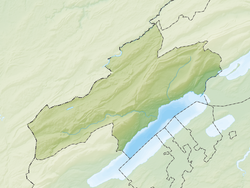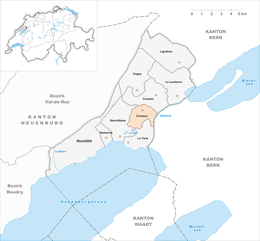Cornaux
| Cornaux | ||
|---|---|---|
|
||
| Coordinates: 47°2′N 7°1′E / 47.033°N 7.017°ECoordinates: 47°2′N 7°1′E / 47.033°N 7.017°E | ||
| Country | Switzerland | |
| Canton | Neuchâtel | |
| District | Neuchâtel | |
| Area | ||
| • Total | 4.72 km2 (1.82 sq mi) | |
| Elevation | 440 m (1,440 ft) | |
| Population (Dec 2015) | ||
| • Total | 1,592 | |
| • Density | 340/km2 (870/sq mi) | |
| Postal code | 2087 | |
| SFOS number | 6451 | |
| Surrounded by | Cressier, Gals (BE), Saint-Blaise, Thielle-Wavre | |
| Website |
www SFSO statistics |
|
Cornaux is a municipality in the district of Neuchâtel in the Swiss canton of Neuchâtel.
Cornaux is first mentioned in 1212 as Curnaul.
Cornaux has an area, as of 2009[update], of 4.7 square kilometers (1.8 sq mi). Of this area, 2.16 km2 (0.83 sq mi) or 45.8% is used for agricultural purposes, while 1.05 km2 (0.41 sq mi) or 22.2% is forested. Of the rest of the land, 1.47 km2 (0.57 sq mi) or 31.1% is settled (buildings or roads), 0.03 km2 (7.4 acres) or 0.6% is either rivers or lakes and 0.01 km2 (2.5 acres) or 0.2% is unproductive land.
Of the built up area, industrial buildings made up 9.7% of the total area while housing and buildings made up 4.4% and transportation infrastructure made up 8.7%. Power and water infrastructure as well as other special developed areas made up 7.2% of the area while parks, green belts and sports fields made up 1.1%. Out of the forested land, 20.3% of the total land area is heavily forested and 1.9% is covered with orchards or small clusters of trees. Of the agricultural land, 35.2% is used for growing crops and 5.7% is pastures, while 4.9% is used for orchards or vine crops. All the water in the municipality is flowing water.
The municipality is located at the foot of the Jura Mountains.
The blazon of the municipal coat of arms is Azure, a Sun in splendour Or, in chief two Trefoils Argent.
Cornaux has a population (as of December 2015[update]) of 1,592. As of 2008[update], 19.4% of the population are resident foreign nationals. Over the last 10 years (2000–2010) the population has changed at a rate of 3.6%. It has changed at a rate of 0.1% due to migration and at a rate of 3.8% due to births and deaths.
...
Wikipedia




